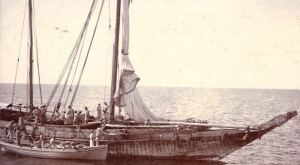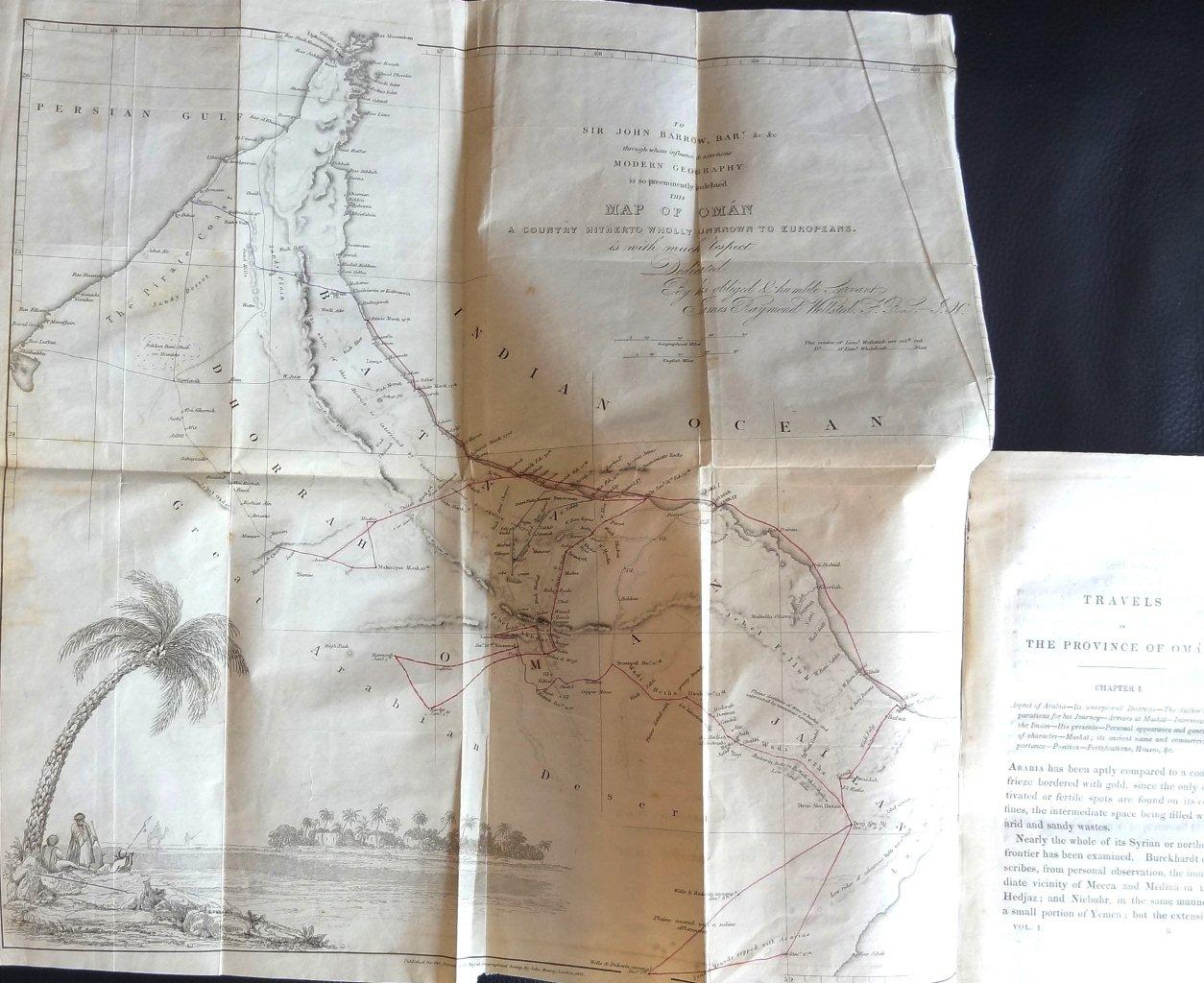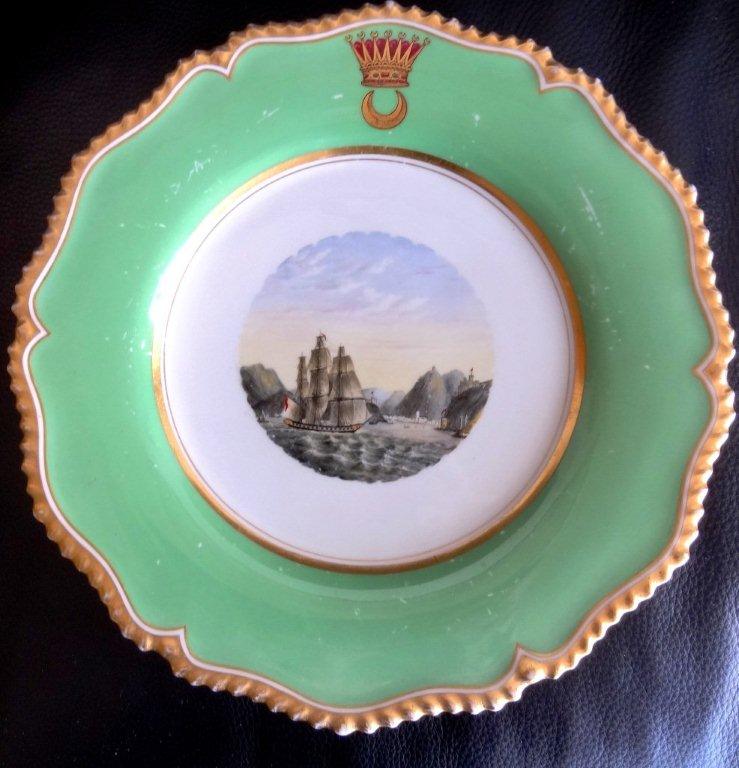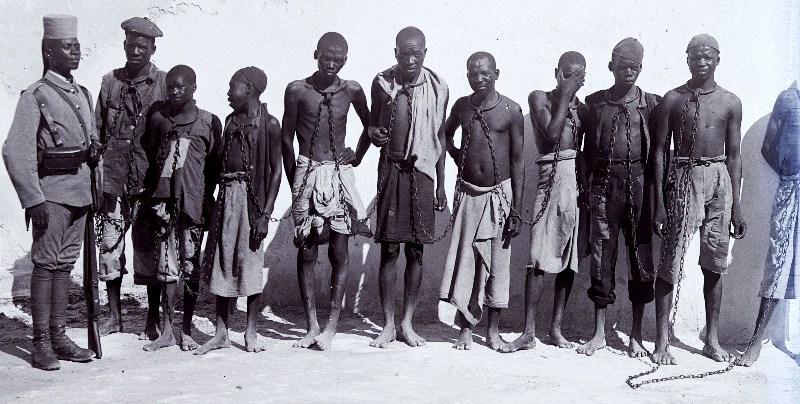 |
|
Omani Boom ship
|
The main monsoons are The South-West monsoon (April/May) that would take your sailing ship to East Africa or the North-East monsoon that would take you to India or further in the direction of China. How to best exploit these monsoons was described in an Omani handbook named " The mine of secrets in the science of the sea" by Shaikh Nasr bin Ali al-Haduri.
In a much earlier work the classic Greek nautical work "The Periplus of the Erythraen sea" a voyage in the Indian Ocean is described to fetch Incense by the Greeks. This implies that the Greek were travelling to The Yemen or more likely to Dhofar in southern Oman. This work dates Probably from around a 100 BC.

Ptolemy-map of Arabia by Lorentz Fries dated 1541, the oldest map of Arabia in our collection
Bottom left is the African coast and on the left is the Red Sea
Archaeological finds suggest that even long before this time there was already trade in Oman with the Indus valley and Mesopotamia, the trade may have involved copper ingots and steatite vases.
During the middle ages the dominant sea power in that period was the kingdom of Hormuz based on the island of Hormuz previously known as Jerun.and which controlled the major harbors on the Omani coasts like Sur, Qalhat and Dhofar. Ships from Sur and Qalhat Sailed to China to buy porcelain of which a great many shards still can be found in Qalhat. The Kingdom of Hormuz was run by Persians (probably Shirazi) and Arabs (probably Omani) The Persians may be the Shirazzi often referred to in the early history of East Africa. The ancient Omani town of Qalhat was visited by Marco Polo. Maybe the Kingdom of Hormuz should be compared to the European Hanseatic league of town-states of the middle ages. The early cities along the East African coast are were probably also part of this League of city states, with the Omani and Persians playing a leading role.


By the end of the 15th century an Omani sailor named Ahmad bin Majid probably guided the Portuguese Vasco da Gama across the Indian Ocean. Later followed by a violent Portuguese invasion of most strategic harbours in the region. The old port of Qalhat was sacked by the Portuguese ( the ruins can still be seen today) The Portuguese built big fortresses in Muscat. By 1650 the Omani got rid of the Portuguese in their entire country. Subsequently over a long period the Omani conquered back all their old "possessions" abroad including Zanzibar from the Portuguese.
Very recently the wreck of a Portuguese ship from the early 16th century (!!) has been found of the coast of southern Oman ( Al Hallaniyah island) The ship was possibly part of the fleet of Vasco da Gama. For more details click the link to the relevant Geographical Journal article by : http://news.nationalgeographic.com/2016/03/20160314-oman-shipwreck-explorer-vasco-da-gama-age-of-exploration-india-route/

In 1672 a Dutchmen (Padtbrugge) visited Muscat and wrote a report about it. "He observed that most trading and crafts were done by people from Sind and by Banyans (Hindu) who made use of prisoners from Diu ( a Portuguese colony in India) However you find a lot of Arab and Persian sword makers. Also blacksmiths who make canon balls, because the Omani do not know how to melt and cast iron. The coppersmiths are very skilled and when they are finished with their work you can not see the hammer-beats in the copper.To achieve this they use a special red soil, that the Dutchmen intended to purchase (in Persia) and take with them to Holland. The same red soil also is used to give red leather a very fresh red colour. All copper pots and dishes are tinned, just like in Persia. The pottery skills are praised highly, in particular in the making of fine praying beads. The potters are very skilled in glazing their pots. The colour of the glazes is red, if it is fired plus some black dust it becomes a black glaze and if some copper is added it gives a green glaze) During the trade negotiations the Sultan indicated that he would like to have 200 Singalese guns (matchlocks) inlaid with silver on the front the middle an at the end of the barrel. The bore of the barrel should be so narrow that only pink can fit in. The barrels must be made of thick iron. The Dutchmen did not agree to supply these guns but gave him 6 guns as a present"

View of Muscat in Dapper dated 1680
From 1744 the Omani intensified again the trade with East Africa, in particular slaves and Ivory.
In 1763 a Dutch VOC ship stranded on the coast of Oman. The surviving part of the crew walked back to civilization along the coast in the direction of Sur / Ras. A printed journal describing their journey has been recovered a couple of years ago (see references) During 2013 efforts were made to find the wreck, but due to very bad visibility in the water the attempt was abandoned.
In 1821 the British sent an expedition to attack the pirates of Bani Bu Ali (close to Ras al Had) however they were complete beaten by the Qasimi / Omani pirates with their swords and matchlocks. In a second British expedition with the help of the Sultan Of Oman the pirates were destroyed.
Around 1810 the Omani Saleh bin Haramil al Abray introduced the clove tree on his Mtoni estate in Zanzibar. The French had already done so successfully in other parts of East Africa. Saleh was a genuine Francophile and obviously a supporter of the French. In 1828 Saiyid Sa'id (Sultan of Oman and Zanzibar) visited Zanzibar for 3 months. The Sultan had strong ties with the British. He put Saleh into prison because he had sold slaves to Christian nations. (which was against the Moresby treaty with the British) and confiscated Saleh's Mtoni estate. The Sultan subsequently had clove tress planted all over the island of Zanzibar. This eventually changed the fortunes of Zanzibar! At Mtoni he build huge large palace that would house over a thousand people (see Photos Zanzibar section) In 1832 Saiyid Sa'id moves his capital from Oman to Zanzibar. According to the explorer Richard Burton Mtony palace looked like the Gothic castle of a German Prince.
The planting and harvesting of cloves required a lot of labour. This was achieved by increasing the number of slaves working on the island. The slaves were captured by African tribal chiefs during wars with other tribes and sold to Arab slave traders and e.g. via the harbour of Bagamoyo transported to Zanzibar were they were sold on the slave-market. Most slaves subsequently being exported to the Middle East. The most famous slave trader during the 19th century was Tippu Tip, see the Slavery section and References section for his very interesting memoirs.
In 1835 the British military Wellsted and Whitelock explored the interior of Oman and produced the first book dedicated to Oman (Travels in Arabia) see our antique book section. This rare and valuable book includes the first detailed map of Oman

First detailed map of Interior Oman by Wellsted dated 1838 (1837 in Royal Geogr Soc.)
Around 1836 The 74-gun ship Liverpool was given by the Imam (Sultan) of Muscat [Saiyid Sa'id] to the British King William IV. In 1837 The king send a ship the Prince Regent (with a royal dinner service on board) all as a present to the Sultan (see our Imports to Oman section)

In 1840 The Omani ship Sultanah visits New York. Zanzibar becomes very prosperous from the clove trade. Already early in the 19-th century a large part of the date harvest of Oman was exported to the USA. So Oman and the USA have close business ties for the last 200 years.
In 1856 Saiyid Sa'id died and two of his sons wanted to succeeded him. In true Machiavellian style the British persuaded the two heirs to split the prosperous Zanzibar and much poorer Oman between them. The objective of this "divide and rule tactic" being to reduce the military power of all nations along the India to England sea route. This route was of crucial economic importance to Britain. The same "divide and rule" tactic was used by the British in the 1920's when they helped to broker a treaty between the Sultan and the Omani tribes in the interior, this was the "treaty of Sib" .
As gradually sailing ships were replaced by steamships the role of Muscat continued to decline. This process continued more or less until in 1970 sultan Qaboos came power and started to explore its oil wealth. By 1970 Oman was a very poor country.
In 1866 Princess BIbi Salme (daughter of Saiyid Sa'id) fell in love with the German merchant Ruete. She got pregnant and escaped to Aden. Later she moved with her husband to Hamburg. Seen our antique books section for her memoirs (we have copies that belonged to the princess and her son)

Rare German first edition of Memoirs of an Arabian Princess by Bibi Salme (=Emily Ruete)

Forced labourers of the Germans in East Africa guarded by an Ashkari soldier
In 1896 the "Shortest war in History" takes place (lasting 38 minutes) The Sultan of Zanzibar surrenders after British warships bomb his palace to ruins. See our Links section for details and the References section for a miniature Koran that was "found" by a British soldier in the ruins of the Sultan´s palace.
Short Youtube film regarding production of incense in Oman
Youtube film regarding the ancient incense trail from Oman
(Part of a series shown on TV in Europe)
Youtube film by the British Library regarding the (rather monotonous) music of Omani sailors
Youtube film regarding the Geology of Oman
Youtube film regarding Omani caves:
Omani Caves: Oman has some of the largest caves in the world (I happened to pass by when the Majlis Al Jinn part of this film was being made) A fascinating German Youtube film showing e.g. the Majlis Al Jinn cave and several other caves!!
Spectacular diving with a parachute into the giant Majlis al Jinn Cave with a parachute in Oman,
Youtube film about diving in the sea in Oman:
Youtube film about the horned viper snake in Oman (I had one in my garden):